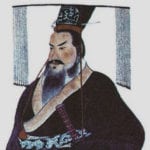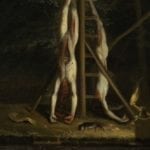 Technology
Technology  Technology
Technology  Humans
Humans 10 Everyday Human Behaviors That Are Actually Survival Instincts
 Animals
Animals 10 Animals That Humiliated and Harmed Historical Leaders
 History
History 10 Most Influential Protests in Modern History
 Creepy
Creepy 10 More Representations of Death from Myth, Legend, and Folktale
 Technology
Technology 10 Scientific Breakthroughs of 2025 That’ll Change Everything
 Our World
Our World 10 Ways Icelandic Culture Makes Other Countries Look Boring
 Misconceptions
Misconceptions 10 Common Misconceptions About the Victorian Era
 Mysteries
Mysteries 10 Strange Unexplained Mysteries of 2025
 Miscellaneous
Miscellaneous 10 of History’s Most Bell-Ringing Finishing Moves
 Technology
Technology Top 10 Everyday Tech Buzzwords That Hide a Darker Past
 Humans
Humans 10 Everyday Human Behaviors That Are Actually Survival Instincts
 Animals
Animals 10 Animals That Humiliated and Harmed Historical Leaders
Who's Behind Listverse?

Jamie Frater
Head Editor
Jamie founded Listverse due to an insatiable desire to share fascinating, obscure, and bizarre facts. He has been a guest speaker on numerous national radio and television stations and is a five time published author.
More About Us History
History 10 Most Influential Protests in Modern History
 Creepy
Creepy 10 More Representations of Death from Myth, Legend, and Folktale
 Technology
Technology 10 Scientific Breakthroughs of 2025 That’ll Change Everything
 Our World
Our World 10 Ways Icelandic Culture Makes Other Countries Look Boring
 Misconceptions
Misconceptions 10 Common Misconceptions About the Victorian Era
 Mysteries
Mysteries 10 Strange Unexplained Mysteries of 2025
 Miscellaneous
Miscellaneous 10 of History’s Most Bell-Ringing Finishing Moves
10 Coincidences That Helped Shape US History
Sometimes, it’s better to be lucky than good. Other times, if it weren’t for bad luck, we’d have no luck at all. In both cases, the cosmic game of chance can twist and turn on a dime, shaping history for better or worse through sheer, often stunning coincidence.
From the nation’s very existence to its national pastime, fortune has played as key a role as fortitude in winning the day. Conversely, seemingly insignificant circumstances—including, of all things, a window frame—have played outsize roles in determining the direction of the nation.
10 The Fortuitous Fog That Saved Washington’s Army
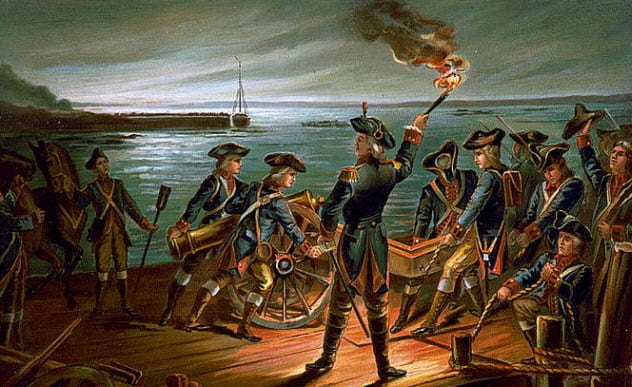
The United States came incredibly close to surviving a grand total of six weeks.
In August 1776, General George Washington and the bulk of the Continental Army were defending present-day Brooklyn. In what became known as the Battle of Long Island, his forces were outnumbered, outflanked, and outfought. Even considering the lopsided British victories during the war’s early stages, this was an outright disaster. On August 27, 970 Continental soldiers were dead or wounded and more than 1,000 were taken prisoner. Meanwhile, the British lost just 63 men.
Washington had his back to the East River and at least 15,000 British Redcoats closing in. Then Mother Nature saved the United States.
The next day, it poured, pausing both armies. On August 29, the British decided to wait out a dense morning fog before striking a decisive blow.
Around noon, Washington ordered his men “to impress every kind of water craft . . . that could be kept afloat . . . and have them all in the east harbor of the city by dark.” Extremely atypical of New York summer weather, the fog held the entire day, enabling an ever-so-silent nighttime evacuation across the river to Manhattan.[1]
The fortuitous fog saved about 9,000 men that the fledgling Continental Army simply could not afford to lose. The cause would almost certainly have been lost that day. Instead, the British awoke the morning of August 30 to capture an enemy that had literally vanished into thin—or rather, thick—air.
9 Don’t I Know You? Lewis, Clark, And A Tribal Chief’s Long-Lost Sister
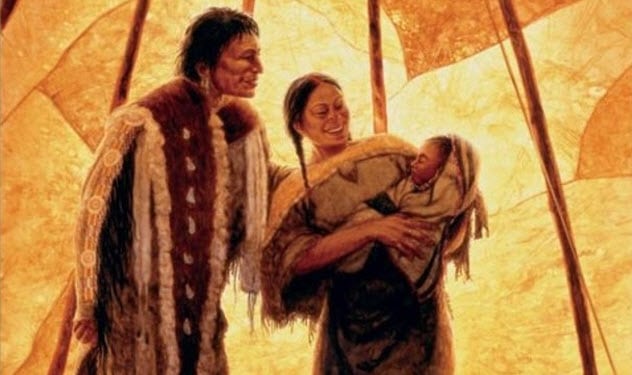
Dense forests, deep rivers, vast plains. Meriwether Lewis and William Clark braved forbidding, unexplored (by white men) wilderness in their search for the ultimately mythical Northwest Passage. Beginning in May 1804 (following the Louisiana Purchase), the now-legendary Corps of Discovery Expedition brought the explorers from St. Louis all the way west to the Pacific Ocean.
Of the myriad factors impossible for Lewis and Clark to have anticipated, none loomed larger than the Rocky Mountains. The Corps needed horses to get across the Rockies and didn’t have them. The Shoshone tribe had horses, but they had never seen white people before.
But they had seen Sacagawea. Incredibly, she was the long-lost sister of the tribe’s chief, Cameahwait.[2]
Far from being a guide on the expedition, Sacagawea had been kidnapped from the Shoshone as a young girl by a rival band and eventually sold to a French-Canadian trapper accompanying the trip.
In an instant, Sacagawea went from slave to lifesaver. The chief thanked the corps for the joyous occasion with horses, supplies, and guides. Who knows when or if America would have laid claim to the remainder of the continent were it not for the luckiest family reunion in US history.
8 The ‘Pick from Heaven’ That Gave Rise To America’s Pastime

Nothing is more American than baseball. Since its first official game played in Hoboken, New Jersey, in 1846, the old ballgame has been remarkably consistent. Familiarities like nine innings per game and nine players per team have been part of baseball since its first official rules, published barely a decade into the game’s existence in 1857.
But no single statute shaped the game like the distance between bases: exactly 27.432 meters (90 ft). Without that exact distance (in feet), the game would have been so drastically different that it may never have proven so enduringly popular.
Baseball is a game of inches played on a sprawling field. Routine plays—for example, a grounder to the shortstop—often result in close plays at first base. Generally, the runner is out or safe by just a step or two. The arbitrariness of 27.432 meters (90 ft) is so fortuitously perfect that its adoption so early in the game’s life span has been called the “pick from heaven.”[3]
Those writing the rules in 1857 couldn’t possibly have predicted modern superstars like Mike Trout getting nipped at first by milliseconds or Jose Altuve stealing a base by a fingertip. Considering its tremendous significance, 90 is the luckiest number in all of American sports.
7 Hide-And-Go-Shoot: The Lost Company That Saved The Union
As brutal and impassioned as the US Civil War was, historians like the renowned Shelby Foote knew that the South’s odds of prevailing were incredibly long. The Union had more than twice as many soldiers and far more manufacturing resources than the Confederacy.
One of the rare chances for the South to potentially win the war came at Gettysburg’s Battle of Little Round Top. If the Confederates had taken this strategically important hill, they would have turned the Union flank and imperiled their position throughout the broader landscape.
Many know about Joshua Lawrence Chamberlain’s famed bayonet charge. And while it’s true that the unorthodox desperation tactic led to many Alabamans surrendering, other rebel troops made a beeline toward a wall to regroup. Had they reached the position, their superior ammunition levels may have turned the tide back in their favor.
But by sheer luck, behind the wall were about 40 Union soldiers led by Captain Walter Morrill, who had been cut off from Chamberlain’s line hours earlier. For over one hour, these men had been hiding so effectively that no one, not even Chamberlain, knew they were there.
The ensuing barrage of bullets led to scores more Confederates killed. The rest surrendered or fled. The hidden heroes of Little Round Top had saved the day, and with it, perhaps the Union cause itself.[4]
6 You (Only) Sunk My Battleship: Pearl Harbor Could Have Been Far Worse
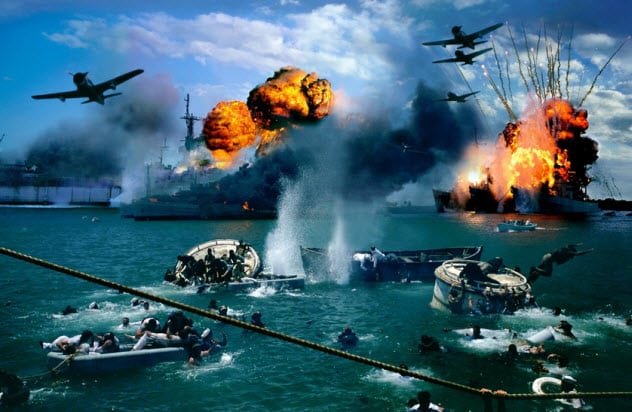
The Japanese attack on Pearl Harbor on December 7, 1941, was an unmitigated disaster. The stats: 2,403 Americans killed, nearly 1,200 wounded, over 325 US planes destroyed or damaged, and 19 ships (including eight battleships) severely impaired or destroyed.
Amazingly, the losses would have been far worse if not for some incredible good luck. By sheer coincidence, all three of the aircraft carriers assigned to Pearl Harbor were off-site that day.
The USS Lexington had left Pearl Harbor on December 5 to transport a dive bomber division to Midway Island, while the USS Saratoga had recently completed a lengthy retrofit on the mainland and was days away from returning to Hawaii.[5]
Most fortunate of all, the USS Enterprise had been delivering a Marine fighter squadron to Wake Island. The carrier was scheduled to return to Pearl Harbor on December 6, but bad weather delayed its estimated arrival until the following afternoon. As a result, it missed the surprise attack by mere hours.
Considering how vital air superiority is in modern warfare, the uphill climb to retake the Pacific would have taken far longer if the US had lost its air carriers that day. Also, in the immediate aftermath of Pearl Harbor, America’s fears of a Japanese attack on the West Coast may have become reality, killing untold numbers of civilians.
5 Let Them Eat Popcorn: The Accidental Invention Of The Microwave
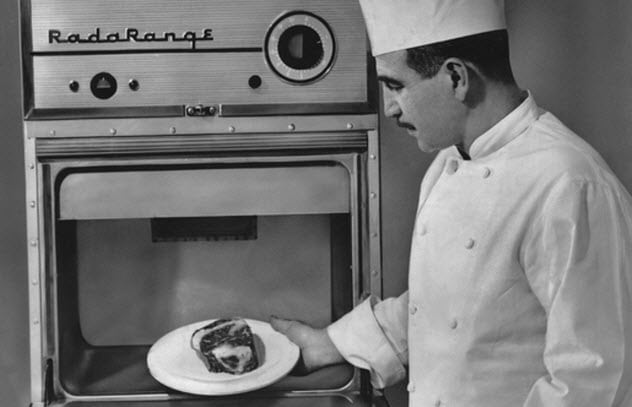
Perhaps the only thing as American as baseball is fast food. And the household item we use for the fastest food possible happened because a physicist had a sweet tooth.
Percy Spencer was a physicist—a pretty good one, actually. During World War II, he’d worked with the military to invent a more efficient radar system that relied on microwave radio signals generated by something called a magnetron.[6]
One day as he was building magnetrons, Spencer discovered that a candy bar in his pocket had melted. Testing his fledgling theory, he experimented with a variety of foods, including popcorn kernels. Soon, Spencer had built the first true microwave oven by enclosing the heat-producing energy in a metal box, which controlled the whole heating process.
Though patented in 1946, the first mass-produced microwave oven wasn’t introduced until 1967 because the technology took that long to condense and make reasonably affordable. By 1975, a million were sold in the US every year. What would America be without pizza rolls and Hot Pockets?
4 The Window Frame That Doomed JFK
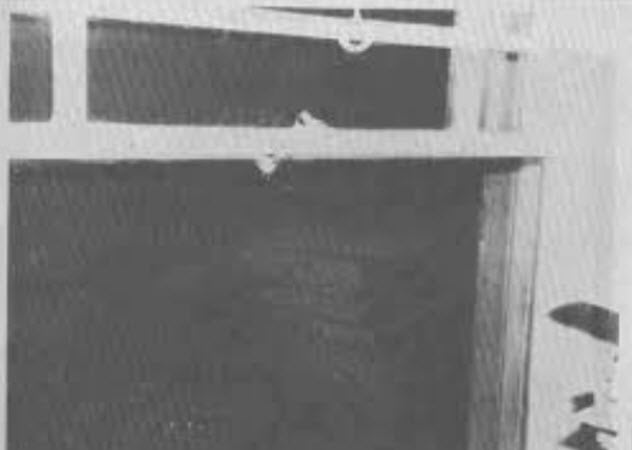
Seven months before he assassinated President John F. Kennedy, Lee Harvey Oswald did what he’d done pretty much his whole life until that fateful day in Dealey Plaza: He failed.
After failing as a US Marine, failing to gain his desired celebrity as a defector in and then back from the USSR, and failing to provide for his wife and young children, Oswald came as close as he’d ever come to accomplishing something when he nearly assassinated Major General Edwin Walker on April 10, 1963.
Among other right-leaning tendencies, Walker was an ardent anti-communist. With his romanticism for the Soviet Union and Cuba, Oswald had found an ideal target for his marksmanship. Until a window frame intervened.[7]
The bullet grazed the frame before basically parting Walker’s hair—the nearest of near misses.
Had Oswald succeeded in killing Walker, two possibilities may have saved JFK. First would have been a far broader police investigation that may have apprehended Oswald. If that had happened, Oswald’s raging desire to be significant may have finally been fulfilled. Also, his lifelong losing streak may have been snapped if his bullet had not nicked that frame. A thin slice of wood may have immeasurably altered US history.
3 Hole In Two: The Confusing Ballot That Swayed The 2000 Election
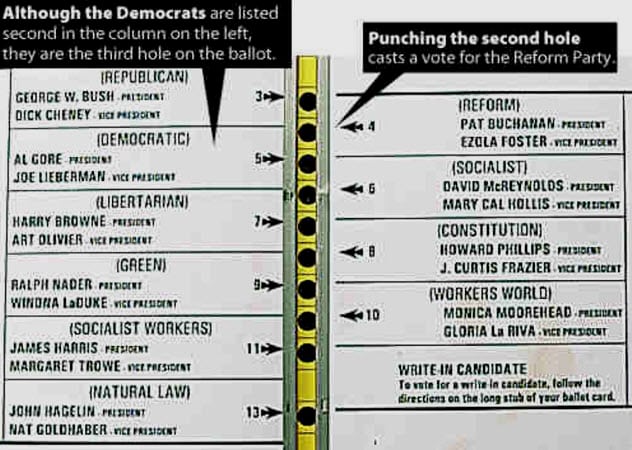
The month-long Florida recount battle to decide the 2000 presidential election had X factors galore. A partisan, cherry-picked recount demand by Al Gore and an alleged voter roll purge of Jacksonville-area African Americans were just two controversies.
But the freakiest and perhaps most damning oddity was Palm Beach County’s “butterfly ballot,” a punch card design that laid out the candidates’ names on two pages rather than one. This allowed the use of larger font sizes for the area’s sizable elderly population.[8]
Good intentions, unintended results: The ballot ended up confusing the heck out of voters—so many, in fact, that it likely cost Gore the presidency.
Some 6,600 voters punched Al Gore’s name and that of another candidate—usually the Reform Party’s Pat Buchanan, atypically placed above the major party Democrat on the ballot—nullifying their votes. About 1,600 punched George W. Bush and another, nullifying their votes. Considering that Bush officially won Florida—and with it, the White House—by just 537 votes, it’s believable that several times that many voters intended to vote for Gore in Palm Beach.
2 The Ill-Timed Financial Crisis That Flatlined McCain’s 2008 Presidential Run
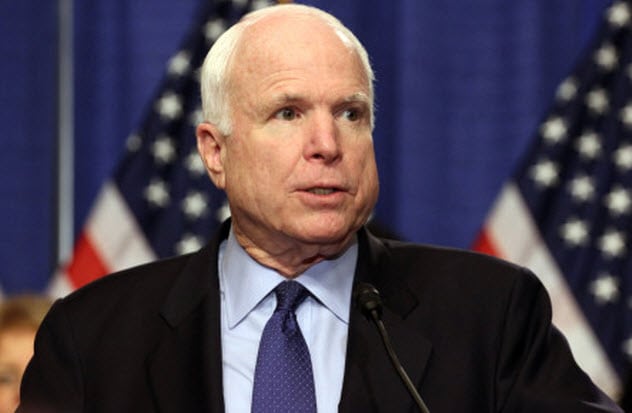
Luck giveth, luck taketh away. Eight years later, it was the Republican candidate who got extremely unlucky. This time, it was something far bigger than a ballot.
The final tallies from the 2008 presidential election appear closer to a rout than a nail-biter. Barack Obama won nearly 10 million more votes than John McCain and won the electoral college by a decisive 365–173.
But a nail-biter it was. In fact, many polls in early September had the race deadlocked. Then the economic system of the United States almost collapsed.
Of course, the financial crisis itself was no coincidence, having resulted from poor policy-making by both parties. The coincidence was this long-simmering pot coming to a rolling boil less than two months before a presidential election.
The collapse of Lehman Brothers on September 15, 2008. The government takeover of Fannie Mae and Freddie Mac on September 17. The bank bailout on October 3. Game, set, and match.
When a law called the Emergency Economic Stabilization Act passes a month before a presidential election, the party of the sitting president loses.[9] Far from being a landslide loser, John McCain was a victim of circumstance with a real chance at winning just weeks earlier.
1 The Inglorious Return Of Carlos Danger

Let’s not relitigate the 2016 US presidential election. In a contest where the winner lost the popular vote and won three decisive states by less than 80,000 votes combined, anything and everything that happened may have swayed it.
So let’s not argue. Rather, let’s all agree on this: It sure is some creepy coincidence that the husband of one of the candidate’s top aides liked to sext with his kid in the background. And that coincidence led to an unforeseen final chapter in the saga of Hillary Clinton’s emails.
Oh, and did we mention that the guy’s name is Weiner?
So, an investigation that was conducted and completed by the FBI—the probe into Clinton’s use of a private email server during her time as secretary of state—was reopened only because the husband of a staffer did something so egregious that it warranted an investigation by the FBI.[10]
And Weiner, also known by his avatar pseudonym Carlos Danger, managed to accomplish all this during the final stages of the ugliest presidential race ever. You take the cake, Carlos. Just don’t take any more photos.
Christopher Dale frequently writes on society, politics, and sobriety-based issues. His work has appeared in The Daily Beast, NY Daily News, Parents.com, and New York Newsday, and he regularly contributes to TheFix.com, a sober-lifestyle website. Follow him on Twitter.
Read about more coincidences and minor events that impacted US history on 10 Notable Coincidences of the American Civil War and 10 Minor Things That Changed The Course Of History.




